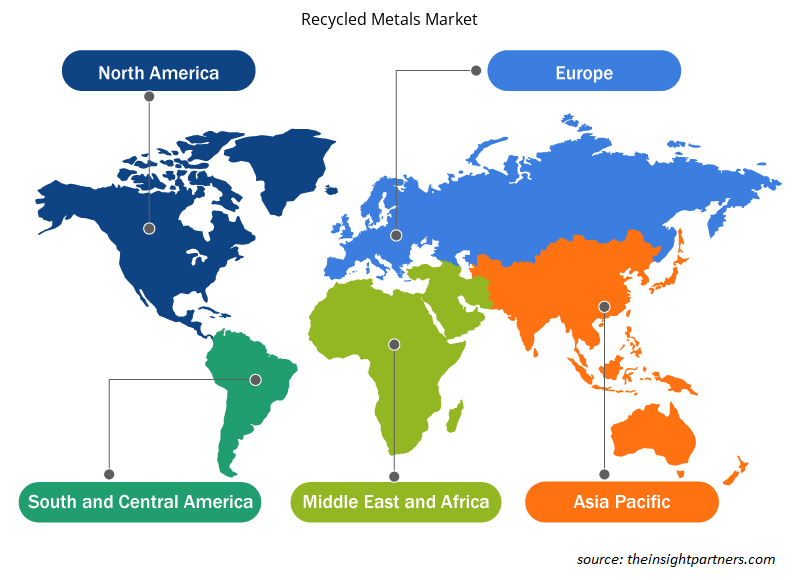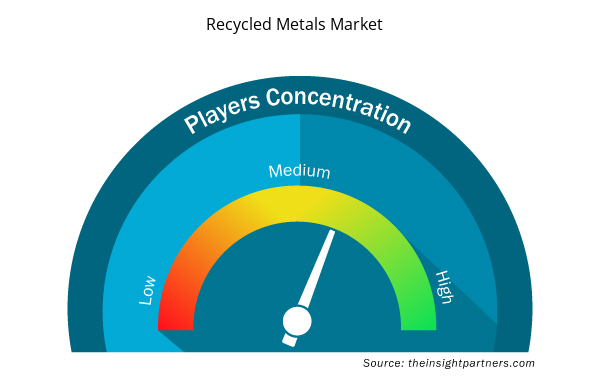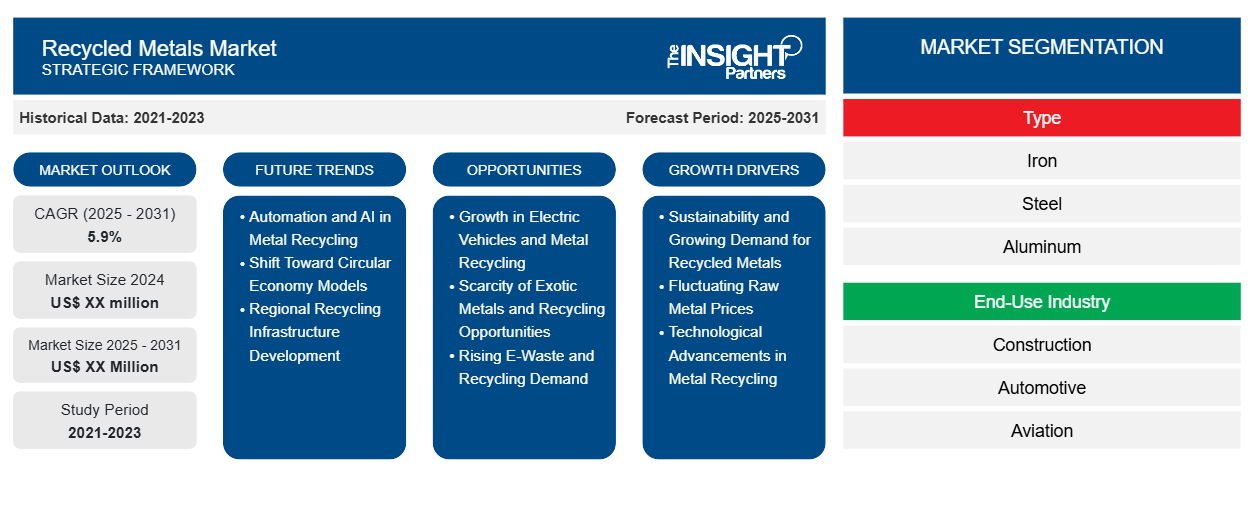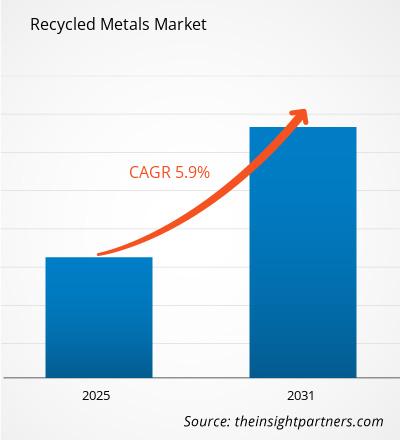Es wird erwartet, dass der Markt für recycelte Metalle von 2023 bis 2031 eine durchschnittliche jährliche Wachstumsrate von 5,9 % verzeichnet, wobei die Marktgröße von XX Millionen US-Dollar im Jahr 2023 auf XX Millionen US-Dollar bis 2031 wächst.
Der Bericht ist nach Typ (Eisen, Stahl, Aluminium, Kupfer, Nickel, Platin, Blei, Zinn und andere) segmentiert. Der Bericht ist weiter nach Endverbrauchsbranche (Bau, Automobil, Luftfahrt, langlebige Konsumgüter, Industriemaschinen, Verpackung und andere) segmentiert. Der Berichtsumfang umfasst fünf Regionen: Nordamerika, Europa, Asien-Pazifik, Naher Osten und Afrika sowie Süd- und Mittelamerika und Schlüsselländer in jeder Region. Die globale Analyse ist weiter auf regionaler Ebene und nach wichtigen Ländern aufgeschlüsselt. Der Bericht bietet den Wert in USD für die oben genannte Analyse und Segmente.
Zweck des Berichts
Der Bericht „Markt für recycelte Metalle“ von The Insight Partners zielt darauf ab, die aktuelle Situation und das zukünftige Wachstum sowie die wichtigsten treibenden Faktoren, Herausforderungen und Chancen zu beschreiben. Dies wird verschiedenen Geschäftspartnern Einblicke geben, wie zum Beispiel:
- Technologieanbieter/-hersteller: Um die sich entwickelnde Marktdynamik zu verstehen und die potenziellen Wachstumschancen zu kennen, damit sie fundierte strategische Entscheidungen treffen können.
- Investoren: Durchführung einer umfassenden Trendanalyse hinsichtlich der Marktwachstumsrate, der finanziellen Marktprognosen und der Chancen entlang der Wertschöpfungskette.
- Regulierungsbehörden: Zur Regulierung von Richtlinien und Überwachungsaktivitäten auf dem Markt mit dem Ziel, Missbrauch zu minimieren, das Vertrauen der Anleger zu bewahren und die Integrität und Stabilität des Marktes aufrechtzuerhalten.
Marktsegmentierung für recycelte Metalle
Typ
- Eisen
- Stahl
- Aluminium
- Kupfer
- Nickel
- Platin
- Führen
- Zinn
Endverbrauchsindustrie
- Konstruktion
- Automobilindustrie
- Luftfahrt
- Gebrauchsgüter
- Industrielle Maschinen
- Verpackung
Passen Sie diesen Bericht Ihren Anforderungen an
Sie erhalten kostenlos individuelle Anpassungen an jedem Bericht, einschließlich Teilen dieses Berichts oder einer Analyse auf Länderebene, eines Excel-Datenpakets sowie tolle Angebote und Rabatte für Start-ups und Universitäten.
- Holen Sie sich die wichtigsten Markttrends aus diesem Bericht.Dieses KOSTENLOSE Beispiel umfasst eine Datenanalyse von Markttrends bis hin zu Schätzungen und Prognosen.
Wachstumstreiber für den Markt für recycelte Metalle
- Nachhaltigkeit und wachsende Nachfrage nach recycelten Metallen: Mit zunehmendem Umweltbewusstsein ist Nachhaltigkeit in der Industrie heute in aller Munde. Regierungen, Unternehmen und Verbraucher werden zunehmend umweltfreundlicher, was die Nachfrage nach recycelten Metallen steigert. Metallurgisches Recycling schont natürliche Ressourcen, spart Energie und verringert die Auswirkungen der Umweltzerstörung. Vorschriften wie Kohlenstoffsteuern und Abfallbewirtschaftungsstandards ermutigen Unternehmen, Modelle der Kreislaufwirtschaft einzuführen, was die Nachfrage nach recycelten Metallen als umweltfreundliche Alternative zu Neumetallen ankurbelt.
- Schwankende Rohmetallpreise: Globale Schwankungen der Preise für Neumetalle (Aluminium, Kupfer und Stahl) wirken sich häufig auf die Nachfrage nach recycelten Metallen aus. Wenn der Abbau von Rohmetallen zu teuer wird, werden sie stattdessen recycelt. Der jüngste Trend zu diesem Phänomen ist in der Automobil- und Bauindustrie zu beobachten, wo die Nachfrage nach Metallen weiterhin hoch ist und Metallrecycling einen Preisvorteil mit Nachhaltigkeit als zusätzlichem Vorteil bietet. Recycling bietet Unternehmen mit schwankenden Metallpreisen Stabilität, da es eine günstigere Lieferkette bietet.
- Technologische Fortschritte im Metallrecycling: Die technologischen Fortschritte in der Metallrecyclingtechnologie machen die Prozesse effizienter und führen zu qualitativ hochwertigeren Endprodukten. Verbesserte Sortiertechniken ermöglichen eine bessere Nutzung der automatisierten Trennung und ein effektiveres Schmelzen, wodurch eine höhere Reinheit und Ausbeute der zu recycelnden Metalle gewährleistet wird. Innovationen in dieser Technologie haben das Recycling kostengünstiger gemacht und ermöglichen es mehr Branchen, die verfügbaren recycelten Metalle in höherwertigen Anwendungen zu verwenden, darunter in der Elektronik- und Automobilbranche, wo die Materialintegrität sehr hoch ist. Die neueren Recyclingtechnologien machen die Gewinnung von Edelmetallen wirtschaftlicher und verbessern den Gesamtmarkt.
Markttrends für recycelte Metalle
- Automatisierung und KI im Metallrecycling: Automatisierungs- und KI-Technologien werden in die Metallrecyclingbranche integriert, um die Sortierung, Verarbeitung und den Transport von Altmetallen zu optimieren. Automatisierte Sortiersysteme auf Basis von KI und maschinellem Lernen verbessern die Identifizierung von Metallen mit größerer Genauigkeit, verbessern die Qualität der recycelten Materialien und senken die Betriebskosten. Innovationen, die durch diese Fortschritte erzielt werden, machen den Recyclingprozess schneller und sicherer, ein Vorteil, den sowohl Großrecycler als auch kleine Unternehmen zu schätzen wissen.recyclers and small businesses appreciate.
- Umstellung auf Kreislaufwirtschaftsmodelle: Immer mehr Branchen setzen auf Kreislaufwirtschaftsmodelle, bei denen nicht nur Altmetalle recycelt, sondern auch Produkte entwickelt werden, die leichter zu recyceln sind. Dies ist in vielen Branchen der Fall, beispielsweise in der Elektronik-, Automobil- und Verpackungsindustrie, wo die Hersteller recycelbare Metalle in ihre Designs integrieren. Die Unternehmen bieten Rücknahmeprogramme an, um gebrauchte Produkte zum Recycling zu sammeln. Diese Umstellung auf eine Kreislaufwirtschaft hat dem Markt für recycelte Metalle zugutegekommen, da die Versorgung mit Altmetallen zum Recycling zugenommen hat.
- Entwicklung der regionalen Recycling-Infrastruktur: Regionale Recycling-Infrastrukturen und Länder, insbesondere die Länder in der Europäischen Union und Nordamerika, die daran arbeiten, ihre internen Recyclingkapazitäten auszubauen, um ihre Abhängigkeit von importiertem Altmetall zu verringern, gewinnen auf dem Markt für recyceltes Metall zunehmend an Bedeutung. Der regionale Trend geht auch Hand in Hand mit der zunehmenden Bedeutung, die der Senkung der Transportkosten und der Verringerung des CO2-Fußabdrucks beim Transport von Altmetall über Ländergrenzen hinweg beigemessen wird.
Marktchancen für recycelte Metalle
- Wachstum bei Elektrofahrzeugen und Metallrecycling: Weltweit ist ein Wachstum bei Elektrofahrzeugen zu verzeichnen, was die Nachfrage nach Aluminium, Kupfer und Lithium erhöht. Diese Metalle werden in Elektrofahrzeugen verwendet, insbesondere in deren Batterien und Motoren sowie in vielen Karosseriekomponenten, die das Gewicht der Fahrzeuge reduzieren sollen. Ihr Recycling kann eine Möglichkeit sein, die steigende Nachfrage auf umweltfreundliche Weise zu decken. Es besteht die Notwendigkeit, die Verfügbarkeit recycelter Metalle zu erhöhen, um die abgebauten Vorräte zu ergänzen und so die Auswirkungen der Gewinnung dieser Metalle zu mildern.EVs, especially in their batteries and motors and in many body components designed to reduce the weight of the vehicles. Recycling them can serve as an opportunity to address the increasing demand in an environmentally friendly way. There is a need to increase the availability of recycled metals to supplement the mined supplies and consequently alleviate the effects of extracting such metals.
- Knappheit exotischer Metalle und Recyclingmöglichkeiten: Der zunehmende Verbrauch seltener und exotischer Metalle wie Lithium, Kobalt und seltener Erden in elektronischen Produkten und Anlagen für erneuerbare Energien wird einen neuen Markt für das Recyclinggeschäft schaffen. Derzeit gibt es keine Recyclingverfahren für diese Metalle, aber mit der Weiterentwicklung der Technologie könnten neue Technologien rentabel werden, um diese Materialien aus Altelektronik, verbrauchten Batterien und der Infrastruktur für erneuerbare Energien wirtschaftlich zu recyceln. Dies würde eine neue Einnahmequelle für den Markt für recycelte Metalle schaffen und zur weltweiten Umstellung auf sauberere Energie beitragen.
- Steigende Nachfrage nach Elektroschrott und Recycling: Da das Volumen an Elektroschrott weltweit zunimmt, bietet sich in ausrangierten Unterhaltungselektronikgeräten ein beträchtlicher Spielraum für recycelte Metalle. Zu den im Elektroschrott enthaltenen Metallen gehören Gold, Silber, Kupfer und Palladium. Die Vorschriften sowie ein gesteigertes Bewusstsein der Verbraucher würden die Verbesserung der Methoden zum Recycling von Elektroschrott vorantreiben, was der Welt die dringend benötigte Metallquelle bieten und gleichzeitig die Umweltprobleme lösen würde, die durch die Erzeugung von Elektroschrott entstehen. Da die Länder strengere Gesetze zum Recycling von Elektroschrott erlassen, können mehr Unternehmen, die sich auf diese Nische spezialisieren, mehr Marktanteile gewinnen.
Regionale Einblicke in den Markt für recycelte Metalle
Die regionalen Trends und Faktoren, die den Markt für recycelte Metalle während des gesamten Prognosezeitraums beeinflussen, wurden von den Analysten von Insight Partners ausführlich erläutert. In diesem Abschnitt werden auch die Marktsegmente und die Geografie für recycelte Metalle in Nordamerika, Europa, im asiatisch-pazifischen Raum, im Nahen Osten und Afrika sowie in Süd- und Mittelamerika erörtert.

- Holen Sie sich die regionalen Daten für den Markt für recycelte Metalle
Umfang des Marktberichts über recycelte Metalle
| Berichtsattribut | Details |
|---|---|
| Marktgröße im Jahr 2023 | XX Millionen US-Dollar |
| Marktgröße bis 2031 | XX Millionen US-Dollar |
| Globale CAGR (2023 - 2031) | 5,9 % |
| Historische Daten | 2021-2022 |
| Prognosezeitraum | 2024–2031 |
| Abgedeckte Segmente | Nach Typ
|
| Abgedeckte Regionen und Länder | Nordamerika
|
| Marktführer und wichtige Unternehmensprofile |
|
Marktteilnehmerdichte für recycelte Metalle: Auswirkungen auf die Geschäftsdynamik verstehen
Der Markt für recycelte Metalle wächst rasant, angetrieben durch die steigende Nachfrage der Endverbraucher aufgrund von Faktoren wie sich entwickelnden Verbraucherpräferenzen, technologischen Fortschritten und einem größeren Bewusstsein für die Vorteile des Produkts. Mit steigender Nachfrage erweitern Unternehmen ihr Angebot, entwickeln Innovationen, um die Bedürfnisse der Verbraucher zu erfüllen, und nutzen neue Trends, was das Marktwachstum weiter ankurbelt.
Die Marktteilnehmerdichte bezieht sich auf die Verteilung von Firmen oder Unternehmen, die in einem bestimmten Markt oder einer bestimmten Branche tätig sind. Sie gibt an, wie viele Wettbewerber (Marktteilnehmer) in einem bestimmten Marktraum im Verhältnis zu seiner Größe oder seinem gesamten Marktwert präsent sind.
Die wichtigsten auf dem Markt für recycelte Metalle tätigen Unternehmen sind:
- Aaron Metalle
- Century Metal Recycling GmbH
- European Metal Recycling GmbH
- Kuusakoski Group Oy
- Nucor Corporation
Haftungsausschluss : Die oben aufgeführten Unternehmen sind nicht in einer bestimmten Reihenfolge aufgeführt.

- Überblick über die wichtigsten Akteure auf dem Markt für recycelte Metalle
Wichtige Verkaufsargumente
- Umfassende Abdeckung: Der Bericht deckt die Analyse von Produkten, Dienstleistungen, Typen und Endbenutzern des Marktes für recycelte Metalle umfassend ab und bietet einen ganzheitlichen Überblick.
- Expertenanalyse: Der Bericht basiert auf dem umfassenden Verständnis von Branchenexperten und Analysten.
- Aktuelle Informationen: Der Bericht stellt durch die Abdeckung aktueller Informationen und Datentrends Geschäftsrelevanz sicher.
- Anpassungsoptionen: Dieser Bericht kann angepasst werden, um spezifische Kundenanforderungen zu erfüllen und die Geschäftsstrategien optimal anzupassen.
Der Forschungsbericht zum Markt für recycelte Metalle kann daher dabei helfen, die Branchensituation und Wachstumsaussichten zu entschlüsseln und zu verstehen. Obwohl es einige berechtigte Bedenken geben kann, überwiegen die allgemeinen Vorteile dieses Berichts tendenziell die Nachteile.
- Historische Analyse (2 Jahre), Basisjahr, Prognose (7 Jahre) mit CAGR
- PEST- und SWOT-Analyse
- Marktgröße Wert/Volumen – Global, Regional, Land
- Branche und Wettbewerbsumfeld
- Excel-Datensatz


- Thermal Energy Storage Market
- Medical Collagen Market
- Organoids Market
- Intraoperative Neuromonitoring Market
- Lyophilization Services for Biopharmaceuticals Market
- Online Recruitment Market
- Semiconductor Metrology and Inspection Market
- Hydrolyzed Collagen Market
- Medical Second Opinion Market
- Europe Surety Market

Report Coverage
Revenue forecast, Company Analysis, Industry landscape, Growth factors, and Trends

Segment Covered
This text is related
to segments covered.

Regional Scope
North America, Europe, Asia Pacific, Middle East & Africa, South & Central America

Country Scope
This text is related
to country scope.
Häufig gestellte Fragen
Integration of artificial intelligence and automation is expected to be the key market trend.
The report can be delivered in PDF/Word format, we can also share excel data sheet based on request.
On the basis of geography, the recycled metals market is classified into North America, Europe, Asia Pacific, Middle East and Africa, and South and Central America
Schnitzer Steel Industries Inc, ArcelorMittal SA, European Metal Recycling Ltd, Norsk Hydro ASA, Hindalco Industries Ltd, Aurubis AG, Nucor Corp, Commercial Metals Co, Sims Ltd, and DOWA HOLDINGS CO LTD
The major factors driving the recycled metals market are:
1. Increasing Demand for Sustainable Practices.
2. Rising Scrap Metal Prices.
The Recycled Metals Market is estimated to witness a CAGR of 5.9% from 2023 to 2031
Trends and growth analysis reports related to Chemicals and Materials : READ MORE..
The List of Companies
1. Aaron Metals
2. Century Metal Recycling Limited
3. European Metal Recycling Limited
4. Kuusakoski Group Oy
5. Nucor Corporation
6. OmniSource Corp. (Steel Dynamics Inc. )
7. SA Recycling LLC
8. Schnitzer Steel Industries, Inc.
9. Sims Metal Management Ltd
10. Umicore N. V.
The Insight Partners performs research in 4 major stages: Data Collection & Secondary Research, Primary Research, Data Analysis and Data Triangulation & Final Review.
- Data Collection and Secondary Research:
As a market research and consulting firm operating from a decade, we have published and advised several client across the globe. First step for any study will start with an assessment of currently available data and insights from existing reports. Further, historical and current market information is collected from Investor Presentations, Annual Reports, SEC Filings, etc., and other information related to company’s performance and market positioning are gathered from Paid Databases (Factiva, Hoovers, and Reuters) and various other publications available in public domain.
Several associations trade associates, technical forums, institutes, societies and organization are accessed to gain technical as well as market related insights through their publications such as research papers, blogs and press releases related to the studies are referred to get cues about the market. Further, white papers, journals, magazines, and other news articles published in last 3 years are scrutinized and analyzed to understand the current market trends.
- Primary Research:
The primarily interview analysis comprise of data obtained from industry participants interview and answers to survey questions gathered by in-house primary team.
For primary research, interviews are conducted with industry experts/CEOs/Marketing Managers/VPs/Subject Matter Experts from both demand and supply side to get a 360-degree view of the market. The primary team conducts several interviews based on the complexity of the markets to understand the various market trends and dynamics which makes research more credible and precise.
A typical research interview fulfils the following functions:
- Provides first-hand information on the market size, market trends, growth trends, competitive landscape, and outlook
- Validates and strengthens in-house secondary research findings
- Develops the analysis team’s expertise and market understanding
Primary research involves email interactions and telephone interviews for each market, category, segment, and sub-segment across geographies. The participants who typically take part in such a process include, but are not limited to:
- Industry participants: VPs, business development managers, market intelligence managers and national sales managers
- Outside experts: Valuation experts, research analysts and key opinion leaders specializing in the electronics and semiconductor industry.
Below is the breakup of our primary respondents by company, designation, and region:

Once we receive the confirmation from primary research sources or primary respondents, we finalize the base year market estimation and forecast the data as per the macroeconomic and microeconomic factors assessed during data collection.
- Data Analysis:
Once data is validated through both secondary as well as primary respondents, we finalize the market estimations by hypothesis formulation and factor analysis at regional and country level.
- Macro-Economic Factor Analysis:
We analyse macroeconomic indicators such the gross domestic product (GDP), increase in the demand for goods and services across industries, technological advancement, regional economic growth, governmental policies, the influence of COVID-19, PEST analysis, and other aspects. This analysis aids in setting benchmarks for various nations/regions and approximating market splits. Additionally, the general trend of the aforementioned components aid in determining the market's development possibilities.
- Country Level Data:
Various factors that are especially aligned to the country are taken into account to determine the market size for a certain area and country, including the presence of vendors, such as headquarters and offices, the country's GDP, demand patterns, and industry growth. To comprehend the market dynamics for the nation, a number of growth variables, inhibitors, application areas, and current market trends are researched. The aforementioned elements aid in determining the country's overall market's growth potential.
- Company Profile:
The “Table of Contents” is formulated by listing and analyzing more than 25 - 30 companies operating in the market ecosystem across geographies. However, we profile only 10 companies as a standard practice in our syndicate reports. These 10 companies comprise leading, emerging, and regional players. Nonetheless, our analysis is not restricted to the 10 listed companies, we also analyze other companies present in the market to develop a holistic view and understand the prevailing trends. The “Company Profiles” section in the report covers key facts, business description, products & services, financial information, SWOT analysis, and key developments. The financial information presented is extracted from the annual reports and official documents of the publicly listed companies. Upon collecting the information for the sections of respective companies, we verify them via various primary sources and then compile the data in respective company profiles. The company level information helps us in deriving the base number as well as in forecasting the market size.
- Developing Base Number:
Aggregation of sales statistics (2020-2022) and macro-economic factor, and other secondary and primary research insights are utilized to arrive at base number and related market shares for 2022. The data gaps are identified in this step and relevant market data is analyzed, collected from paid primary interviews or databases. On finalizing the base year market size, forecasts are developed on the basis of macro-economic, industry and market growth factors and company level analysis.
- Data Triangulation and Final Review:
The market findings and base year market size calculations are validated from supply as well as demand side. Demand side validations are based on macro-economic factor analysis and benchmarks for respective regions and countries. In case of supply side validations, revenues of major companies are estimated (in case not available) based on industry benchmark, approximate number of employees, product portfolio, and primary interviews revenues are gathered. Further revenue from target product/service segment is assessed to avoid overshooting of market statistics. In case of heavy deviations between supply and demand side values, all thes steps are repeated to achieve synchronization.
We follow an iterative model, wherein we share our research findings with Subject Matter Experts (SME’s) and Key Opinion Leaders (KOLs) until consensus view of the market is not formulated – this model negates any drastic deviation in the opinions of experts. Only validated and universally acceptable research findings are quoted in our reports.
We have important check points that we use to validate our research findings – which we call – data triangulation, where we validate the information, we generate from secondary sources with primary interviews and then we re-validate with our internal data bases and Subject matter experts. This comprehensive model enables us to deliver high quality, reliable data in shortest possible time.


 Holen Sie sich ein kostenloses Muster für diesen Bericht
Holen Sie sich ein kostenloses Muster für diesen Bericht